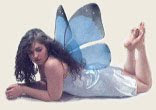Also, Casa Loma has one, and that would just be absolutely fantastic -- to wander around the castle grounds and gardens while it's been made into a faire.
So that's really all the excuse I need to justify another couple of costumes. And the nice thing is, they can all use the same basic costume, with different elements being changed up as I wish. Given that they're all outdoors in the summer, I'd want to make up cotton or linen pieces, so I think I'd go with the basic wench setup -- a blouse and a skirt with some sort of an overskirt or apron, and then a bodice or a corset overtop. I did used to have a nice little wench costume, but none of the components of it were made of natural materials as I was only going to be wearing it at Halloween, and it's also about 4 sizes to small for me now.
I've sketched out my basic idea for the pirate fest - nothing overly creative here. Probably identical to what everyone else will be wearing, but I don't care. We all need a basic set of peasant or wench clothes in our closets. What I'm not sure of is the colour combination:








